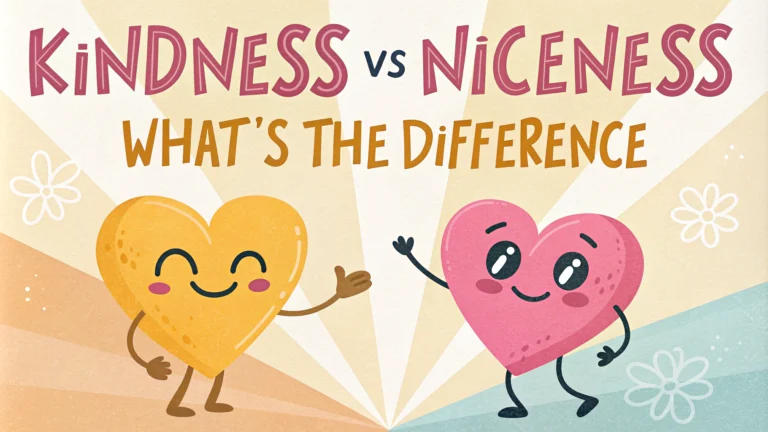Most people use the words kindness and niceness interchangeably, but these qualities have distinct characteristics that shape how we interact with others. **Kindness** comes from genuine care and empathy, while **niceness** often stems from social politeness and convention.
A kind person takes meaningful action based on understanding others’ needs, whereas a nice person might focus on maintaining pleasant appearances. This guide examines these subtle yet significant differences to help you cultivate authentic relationships.
Core Differences Between Kindness and Niceness
**Kindness** requires emotional investment and often involves making difficult choices. **Niceness** typically follows social scripts and avoids conflict.
- Kindness: Driven by empathy and compassion
- Niceness: Motivated by social acceptance
- Kindness: Takes meaningful action
- Niceness: Maintains pleasant appearances
Signs You’re Being Kind Rather Than Nice
**Authentic kindness** shows through specific behaviors and choices that prioritize others’ well-being over social comfort.
- Speaking difficult truths with compassion
- Taking action without expecting recognition
- Setting healthy boundaries
- Showing up during tough times
The Psychology Behind People-Pleasing
Understanding why we default to **niceness** helps break the cycle of superficial interactions. **People-pleasing** often masks deeper needs for validation and acceptance.
| Nice Behavior | Kind Alternative |
|---|---|
| Saying yes to avoid conflict | Setting honest boundaries |
| Hiding true feelings | Expressing genuine concern |
| Following social scripts | Responding authentically |
Moving Beyond Surface-Level Interactions
**Authentic connections** require stepping outside comfort zones and engaging in meaningful dialogue. Building deeper relationships means taking calculated risks in communication.
- Share personal experiences when relevant
- Ask thoughtful questions beyond small talk
- Listen actively without planning responses
- Show vulnerability when appropriate
Building Genuine Relationships Through Kindness
**True kindness** creates lasting bonds through consistent, thoughtful actions. Small gestures backed by genuine intention make significant impact.
| Action | Impact |
|---|---|
| Regular check-ins | Shows reliable support |
| Remembering details | Demonstrates active caring |
| Offering specific help | Provides practical support |
The Impact of Kindness vs. Niceness on Mental Health
Research shows **authentic behavior** reduces anxiety and strengthens self-esteem. Living authentically through kindness creates better mental health outcomes than maintaining surface-level pleasantness.
- Reduced people-pleasing stress
- Increased self-respect
- Stronger emotional boundaries
- More fulfilling relationships
“Kindness without honesty becomes manipulation. Honesty without kindness becomes cruelty.”
Creating Lasting Change Through Authentic Behavior
Shifting from automatic niceness to intentional kindness requires practice and patience. Start with small changes in daily interactions.
Action Steps for Authentic Living:
- Practice saying “no” when needed
- Express genuine opinions respectfully
- Choose meaningful actions over quick fixes
- Reflect on motivation behind social behaviors
Remember that **authentic kindness** grows stronger with consistent practice. Each small choice to act with genuine care builds momentum toward lasting change.
Kindness vs Niceness FAQs
General Questions
Q: What is the main difference between kindness and niceness?
A: Kindness comes from genuine care and empathy, while niceness often stems from social politeness and desire for approval. Kindness involves taking meaningful action, while niceness typically stays on the surface level.
Q: Can someone be nice but not kind?
A: Yes. Nice people may maintain pleasant behavior for social acceptance while avoiding difficult but necessary actions that true kindness requires, like having tough conversations or setting boundaries.
Q: Which is more valuable in professional settings – kindness or niceness?
A: Both have their place, but kindness creates stronger workplace relationships through:
- Honest feedback that helps growth
- Genuine support during challenges
- Taking responsibility for mistakes
- Making difficult decisions for the team’s benefit
Specific Scenarios
Q: How does kindness differ from niceness in conflict resolution?
A: Kind conflict resolution addresses core issues and seeks understanding, while nice behavior might avoid conflict altogether or agree superficially without solving problems.
Q: What are signs someone is being nice but not kind?
A: Key indicators include:
- Avoiding difficult conversations
- People-pleasing behaviors
- Passive-aggressive responses
- Inconsistency between words and actions
Q: How does kindness vs niceness affect mental health?
A: Genuine kindness supports better mental health through authentic connections and self-respect, while constant niceness can lead to burnout and suppressed emotions.
Practical Applications
Q: How can parents teach children the difference between kindness and niceness?
A: Parents can demonstrate through:
- Role-modeling genuine helpful actions
- Discussing the reasoning behind kind choices
- Encouraging empathy over surface-level politeness
- Praising authentic kind behaviors
Q: What are examples of kind actions vs nice gestures?
A:
| Kind Actions | Nice Gestures |
|---|---|
| Offering specific help during crisis | Saying “let me know if you need anything” |
| Having difficult but necessary conversations | Avoiding conflict to maintain peace |
| Setting healthy boundaries | Always saying yes to requests |
Q: How do kind people handle toxic relationships differently from nice people?
A: Kind people establish boundaries and address issues directly, while nice people might enable toxic behavior by avoiding confrontation and maintaining superficial harmony.
Q: Is it possible to balance kindness and niceness?
A: Yes, the optimal approach combines genuine kindness with appropriate social niceness, using each quality in suitable contexts while maintaining authenticity.



















